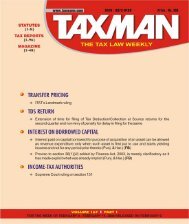CPT V24P7-Art1 (Content).pmd - Taxmann
CPT V24P7-Art1 (Content).pmd - Taxmann
CPT V24P7-Art1 (Content).pmd - Taxmann
You also want an ePaper? Increase the reach of your titles
YUMPU automatically turns print PDFs into web optimized ePapers that Google loves.
LANDMARK RULINGS<br />
684<br />
LANDMARK RULINGS<br />
An Overview of Latest Judgments on<br />
Direct Tax Laws<br />
Scot-free passage for closed PE,<br />
unabsorbed losses can be set-off against<br />
profits of rekindled PE - Singapore Tribunal<br />
In AYN Corporation v. Comptroller of Income<br />
Tax [2012] 23 taxmann.com 223 (ITBR -<br />
Singapore), the appellant, a Japanese company,<br />
was carrying on its business in Singapore through<br />
a branch. Due to losses, the appellant closed<br />
its branch and informed Registrar of Companies<br />
at Singapore. Later on, it opened a new branch<br />
and claimed set-off of unabsorbed losses of<br />
closed branch against profits of new branch.<br />
The Comptroller objected to the same on the<br />
ground that with closure of the branch, the<br />
right to tax the income of branch in Singapore<br />
also ceased and, therefore, losses of closed<br />
branch can’t be set-off against profits of new<br />
branch. Comptroller also contended that branch<br />
was a PE of appellant and it should be treated<br />
as separate entity in view of article 7 of Singapore-<br />
Japan DTAA.<br />
The tax review board held in favour of assessee -<br />
It held as follows:<br />
(a) Section 368 of the Singapore Companies<br />
Act allows a foreign company to set-up<br />
its branch in Singapore to carry on its<br />
business;<br />
(b) Therefore, branch is said to be an extension<br />
of HO and has no separate legal<br />
entity;<br />
August 1 to 15, 2012 u TAXMANN’S CORPORATE PROFESSIONALS TODAY u Vol. 24 u 64<br />
(c) The PE is a mere fiction necessary for<br />
purpose of determining profits under article<br />
7; and<br />
(d) Article 7 is not concerned with how the<br />
profits of PE should be dealt with, such<br />
as allowing losses, etc.<br />
Therefore, it was held that unabsorbed losses<br />
of closed branch could be set off against profits<br />
of new branch.<br />
ITAT allows ESOP expenses, Ranbaxy’s<br />
case differentiated on grounds of<br />
‘expenditure’ and ‘notional loss’<br />
In Addl. CIT v. Spray Engineering Devices<br />
Ltd. [2012] 23 taxmann.com 267 (Chandigarh<br />
- Trib.), the assessee-company passed a resolution<br />
to issue equity shares free of cost to its employees<br />
as Sweat equity. Shares were to be issued with<br />
lock in period of five years; however, no allotment<br />
of such shares was done till the end of relevant<br />
year. The fair value of the shares was debited<br />
to employee benefits (P & L account) with<br />
corresponding credit to shares outstanding<br />
account which was reflected in the balance<br />
sheet. AO denied the allowance for same<br />
contending that it was just a contingent liability.<br />
The Tribunal held in favour of assessee - The<br />
Tribunal held that fair value of sweat equity<br />
issued free of cost by special resolution was<br />
allowed to be deducted under section 37(1).<br />
}











![“FORM NO. 3CEB [See rule 10E] Report from an ... - Taxmann](https://img.yumpu.com/45480232/1/190x245/form-no-3ceb-see-rule-10e-report-from-an-taxmann.jpg?quality=85)





